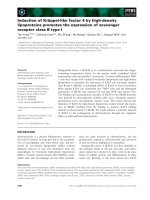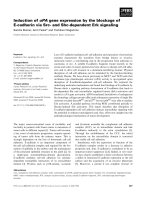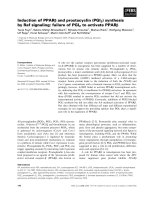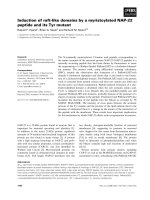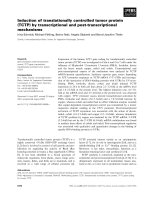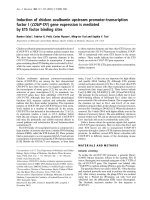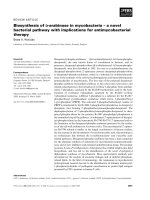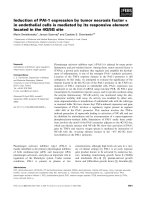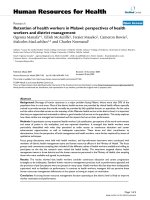Báo cáo sinh học: "Induction of chromosomal sites in goats: a fragile preliminary study" pps
Bạn đang xem bản rút gọn của tài liệu. Xem và tải ngay bản đầy đủ của tài liệu tại đây (1.97 MB, 11 trang )
’
’’Original
article
Induction
of
chromosomal
fragile
sites
in
goats:
a
preliminary
study
NL
López-Corrales,
MV
Arruga*
Departamento
de
Producci6n
Animal
y
Ciencias
de
los
Alimentos,
Facultad
de
Veterinaria
de
la
Universidad
de
Zaragoza,
c/
Miguel
Servet
177,
5001,i
Zaragoza,
Spain
(Received
9
November
1995;
accepted
16
January
1996)
Summary -
The
current
study
describes
the
results
obtained
from
different
methods
of
detection
of
folate-sensitive
fragile
sites
in
goat
chromosomes.
Two
different
types
of
expression
of
chromosomal
fragility
have
been
observed:
telomeric
non-staining
gaps,
in
20
out
of
21
animals
studied,
and
chromatidic
breaks
in
ten
animals.
The
non-staining
gaps
have
been
identified
mainly
in
chromosome
5,
and
their
frequency
of
occurrence
ranged
from
30
to
66%
of
the
cells.
The
chromatidic
break
occurrence
ranged
from
2
to
5%
of
the
cells
among
the
break
carriers.
From
the
methods
used
and
the
observed
frequency
of
expression
in
cultures,
the
gaps
were
classified
as
common
folate-sensitive
fragile
sites.
Significant
differences
between
the induction
methods
used
were
obtained.
’
goat
/
fragile
site
/
folate
deficiency
Résumé -
Induction
de
sites
chromosomiques
fragiles
chez
les
chèvres :
étude
préliminaire.
Cette
étude
décrit
les
résultats
de
différentes
méthodes
de
mise
en
évidence
de
sites
chromosomiques
fragiles
sensibles
au
folate
chez la
chèvre.
Deux
types
différents
d’expression
de
la
fragilité
chromosomique
ont
été
observés :
des
espaces
télomériques
ne
prenant
pas
la
coloration,
sur
20
des
21
animaux
étudiés,
et
des
cassures
chromatidiques
sur
10
animaux.
Les
absences
de
coloration
ont
été
localisées
principalement
sur
le
chro-
mosome
5
et
leur
fréquence
d’apparition
allait
de
30
à
66
%
des
cellules.
Chez
les
por-
teurs
de
cassures,
la
fréquence
de
ces
dernières
allait
de
2 à
5 %
des
cellules.
D’après
les
méthodes
utilisées
et
les
fréquences
observées
dans
les
cultures,
les
zones
chromosomiques
non
colorées
peuvent
être
considérées
comme
appartenant
à la
catégorie
commune
des
sites
fragiles
sensibles
au folate.
Des
différences
significatives
entre
les
méthodes
d’induction
ont
également
été
observées.
chèvre
/
site
fragile
/
déficience
en
folate
’"
Correspondence
and
reprints:
Laboratorio
Citogenetica.
INTRODUCTION
About
one
hundred
chromosomal
fragile
sites
have
been
detected
in
humans
since
the
first
description
was
made
by
Dekaban
in
1965
(Sutherland,
1991).
Human
fragile
sites
have
been
successively
related
to
different
pathologies
and
one
of
the
most
well
known
is
the
association
between
the
mental
retardation
syndrome
and
the
fra.Xq27.3
(Sutherland
and
Baker,
1990;
Vogel
et
al,
1990;
Oberl6
et
al,
1991;
Craig,
1991).
Furthermore,
implications
of
chromosomal
fragility
in
different
processes
like
Bloom
syndrome
(Fundia
et
al,
1992),
chromosomal
viral
integration
points
(Caporossi
et
al,
1991),
chromosomal
evolution
(Mir6
et
al,
1987;
Popescu
et
al,
1990)
and
the
relationship
between
fragile
sites,
oncogenesis
and
tumoral
events
(Yunis,
1983;
Yunis
and
Soreng,
1984;
DeBraeckeler,
1987;
Dal
Cin
et
al,
1991;
Austin
et
al,
1991)
have
been
well
documented
in
human
cytogenetics.
In
animals
only
a
few
chromosomal
fragile
sites
have
been
reported,
mainly
in
domestic
species.
In
pigs,
Riggs
and
Chrisman
(1989,
1991)
have
described
aphidicolin
and
folate-
sensitive
fragile
sites
like
the
ones
detected
by
Yan
and
Long
(1993).
More
recently,
folate,
5-BrdU
and
aphidicoline
fragiles
sites
have
been
found
in
equine,
rabbit,
bovine,
mole
rat,
dog
and
sheep
karyotypes
by
Ronne
(1992),
Poulsen
and
Ronne
(1991),
Uchida
et
al
(1986),
Gripemberg
(1991),
Stone
et
al
(1991a)
and
Matejka
et
al
(1990).
Although
no
close
relationship
with
any
pathology
has
yet
been
observed,
Tewari
et
al
(1987)
have
indicated
a
possible
effect
on
the
fertility
of
female
rats
and
Stone
et
al
(1991b)
have
suggested
the
implication
of
some
fragile
sites
in
tumoral
chromosomal
rearrangements
in
the
mammary
glands
of
dogs.
These
features
and
some
of
the
published
results,
indicate
that
the
fragile
sites
may
be
distributed
in
the
majority
of
domestic
species
in
a
similar
way
as
for
humans.
This
highlights
the
importance
of
knowing
the
distribution
and
morphological
characteristics
of
animal
fragile
sites,
as
a
first
step
to
finding
the
possible
relationships
between
any
defined
pathology
or
syndrome
and
the
presence
of
chromosomal
fragility.
There
is
no
knowledge
of
the
induction
methodologies
or
chromosomal
fragility
expression
forms
in
goats
and
the
aim
of
this
work
has
been
the
adaptation
of
induction
methodologies
to
begin
studies
of
the
detection
and
identification
of
folate-sensitive
fragile
sites
in
this
karyotype.
MATERIAL
AND
METHODS
Twenty-one
adult
goats
were
used,
including
Saanen,
Toggenburg
and
cross-bred
animals.
An
adaptation
of
published
protocols
(Sutherland
et
al
(1985);
Howard-Peebles
(1991);
Fisch
et
al
(1991);
Jacky
et
al
(1991))
was
used
to
induce
the
expression
of
fragile
sites
in
lymphocyte
cultures.
Whole
blood
(1
mL)
was
cultivated
in
10
mL
of
low
folate
M-199
medium
(Flow)
supplemented
with
5%
SFB
(Gibco),
1%
penicillin-streptomycin
(Gibco),
5
IU
of
PHA
(phytohaemaglutinine)
(Wellcome)
and
5
IU
of
Pokeweed
(Gibco)-like
mi-
togens.
The
culture
pH
was
adjusted
to
7.6-7.8
by
the
addition
of
bicarbonate.
Three
modifications
to
this
basic
culture
were
used:
protocol
1:
5
vM
of
fluo-
rodeoxyuridine
FdU
(Sigma,
F
0530)
and
30
mg/mL
of
thymidine
(Sigma,
T
5018)
were
added
during
the
last
24
h
of
cell
culture;
protocol
2:
5
RM
of
fluorodeoxyuri-
dine
(Sigma,
F
5030),
30
mg/mL
of
thymidine
(Sigma,
T
5018)
and
10
!g/mL
5-bromo-2’-deoxyuridine
BrdU
(Sigma,
B
5002)
were
added
during
the
last
24
h
of
cell
culture;
protocol
3:
5
RM
of
fluorodeoxyuridine
(Sigma,
F
5030),
30
mg/mL
of
thymidine
(Sigma,
T
5018),
and
10-
5M
of
amethopterin
and
methotrexate
(Sigma
A
6770)
were
added
during
the
last
24
h
of
cell
culture.
The
cultures
were
harvested
and
fixed
according
to
a
standard
technique
(Moor-
head
et
al,
1960).
Two
cultures
for
each
treatment
were
made
and
50
cells
from
each
one
were
observed.
Control
cultures
were
used
for
each
protocol
according
to
the
standard
methodology:
1
mL
of
whole
blood
in
10
mL
of
RPMI
1640
(Gibco),
supplemented
with
20%
SFB
(bovine
calf
serum)
(Gibco)
and
1%
penicilline-
streptomycin
(Gibco)
and
1%
L
-glutamine
(Sigma).
The
cultures
were
incubated
at
37 °C
in
the
absence
of
C0
2
and
harvested
after
72
h
of
growth.
The
identification
of
chromosome
pairs
was
accomplished
by
an
adaptation
of
the
original
Seabright’s
G
banding
method
(Seabright,
1971).
An
ANOVA
test
was
used
to
establish
the
differences
between
treatments
(Stat
View,
Macintosh).
RESULTS
Two
different
types
of
chromosomal
alterations
were
observed.
The
numbers
given
below
refer
to
protocol
3.
Non-staining
gaps
at
the
telomeric
region
The
results
are
shown
in
figure
la
and
lb.
The
minimum
expression
value
considered
was
4%
of
the
total
observed
cells,
and
only
one
animal
presented
an
expression
percentage
below
this.
Among
the
remaining
20,
the
gaps
were
present
at
a
frequency
of
30-66%
of
the
cells,
with
a
mean
value
of
48.3
t
2.1%.
Cells
with
more
than
one
gap
occurred
at
a
frequency
ranging
from
0-38%
of
the
total,
with
a
mean
value
of
10.5
f
2.3%
(table
I).
After
destaining
and
subsequent
G-banding
the
autosome
pair
number
5
could
be
identified
as
the
main
carrier
of
gaps
(fig
2a,
2b
and
2c).
In
18
animals
(90%
of
the
20),
gaps
on
homologous
chromosome
5
could
be
observed
on
this
pair
(fig
2a
and
2b).
Chromatidic
breaks
The
occurrence
of
chromatidic
breaks
ranged
from
0%
(breaks
were
detected
only
in
ten
animals)
to
4%,
with
a
mean
value
of
1.5 f
0.4%
(table
I).
Unlike
the
gaps,
the
break
locations
were
detected
in
different
regions
and
chromosome
pairs,
and
these
ruptures
were
observed
in
only
one
chromatid
in
all
the
analyzed
cases
(fig
3a
and
3b).
Methodologies
used
The
three
variants
described
were
useful
for
detecting
gaps
and
break
induction.
Considering
the
ANOVA
test
performed,
treatment
3
showed
significant
differences
(p
<
0.05)
from
treatments
1
and
2,
taking
into
account
only
gap
expression
(fig
4).
proliferation
cell
rate
was
lower
when
protocol
2
was
employed.
For
this
reason,
another
comparison
test
between
protocols
1
and
3
was
carried
out
using
18
animals
(fig
5).
The
ANOVA
test
did
not
show
significant
differences,
but
a
slight
increase
in
gap
expression
in
treatment
3
could
be
detected
in
both
comparison
tests
(fig
4
and
5).
DISCUSSION
From
a
morphological
point
of
view,
the
two
types
of
lesions
found
can
be
con-
sidered
as
different
chromosomal
fragility
expression
forms
in
the
goat
karyotype.
The
high
frequency
of
gaps
and
the
constancy
of
their
location
are
two
features
in
agreement
with
the
descriptions
of
other
species
whose
gaps
have
been
the
most
frequent
expression
of
chromosome
fragility.
Matejka
et
al
(1990)
reported
a
mean
value
of
40%
expression
for
a
BrdU
sensitive
fragile
site
located
at
the
eighth
pair
in
sheep,
and
Gripenberg
et
al
(1991)
detected
up
to
86%
expression
in
a
fra.X.
of
deer.
In
humans
the
fra.12q24.2
and
fra.lOq25
are
both
fragile
sites
with
a
high
level
of
expression
in
cultures
(Voiculescou
et
al,
1991;
Tommerup
et
al,
1981;
Gollin
al,
1985).
These
high
expression
values
are
in
agreement
with
the
mean
expression
observed
by
us,
and
reinforce
the
fact
that
our
results
may
represent
a
common
folate-sensitive
fragile
site,
which
shows
a
chromosome
gap
as
its
form
of
expression
in
cell
culture.
Furthermore,
the
three
protocol
modifications
used
were
useful
for
gap
induction.
Even
though
some
of
the
drugs
used
might
have
enhanced
the
expression,
it
can
be
pointed
out
that
the
absence
of
folic
acid
in
the
culture
medium
was
the
main
factor
in
provoking
the
fragile
expression.
A
slight
positive
effect
on
gap
expression
was
detected
only
when
methotrexate
was
added
24
h
before
harvesting
(a
difference
was
observed
mainly
when
a
comparison
was
made
between
treatments
1
and
3).
If
the
effect
produced
by
amethopterin
on
the
condensation
and
chromosome
elongation
is
considered
(Laird
et
al,
1987),
an
increase
of
the
degree
of
stretching
at
the
fragile
region,
and
consequently
a
clearer
observation
on
optical
microscopy,
could
be
a
logical
explanation
for
the
observed
high
level
of
expression
when
this
drug
is
added.
Even
though
in
some
animals
(three),
different
chromosome
pairs
were
detected
to
be
telomeric
gap
carriers,
their
expression
levels
were
<4%
of
the
cells
and
no
chromosome
repetitive
location
was
confirmed;
only
in
the
pair
5
were
the
gap
location
and
frequency
expression
values
good
enough
to
be
considered
a
possible
expression
of
chromosomal
fragility.
One
important
fact
is
that
the
gaps
overlap
the
telomeric
nucleolar
organization
region
(NOR)
in
this
pair.
Consequently
it
is
necessary
to
assume
that
any
stretching
of
the
NOR
region
could
provoke
a
variable
percentage
of
false-positive
fragile
detection.
In
this
work
no
triple
staining
(Giemsa-
G-Banding-NORs)
was
employed,
and
it
is
difficult
to
estimate
what
percentage
of
gaps
might
be
false-positive
due
to
active
NOR
regions
being
detected
as
fragile
sites,
or
indeed
if
all
the
fragile
sites
described
here
are
only
NOR
stretchings.
There
is
some
evidence
that
the
latter
is
not
the
case.
First,
telomeric
gaps
were
detected
only
in
one
(pair
5)
of
the
five
chromosome
carriers
of
NORs
in
goat
(according
to
Di
Meo
et
al,
1991)
pairs
2,
3,
4,
5
and
28
are
NORs
carriers
in
goats.
Secondly,
the
gaps
were
not
limited
to
the
telomere
only,
the
gap
region
involving
all
the
telomeric
positive
R
or
negative
G
bands
of
the
carrier
chromosome.
The
gaps
are
bigger
than
the
NOR
region
detected
with
normal
AG-NOR
(silver
staining
NOR)
staining.
These
features
indicate
that
it
is
not
valid
to
assume
that
all
the
gaps
are
extensions
of
the
NORs,
though
a
percentage
of
false-positives
due
to
this
cannot
be
excluded.
Telomeric
Structural
Changes
(TSC)
have
been
indicated
as
another
source
of
error
when
human
telomeric
fragile
sites
are
analyzed
(Butler
et
al,
1990).
These
TSC
are
chromosomal
lesions
which
can
be
detected
as
fragile
sites
and
the
authors
mentioned
that
about
10%
of
positive
detection
in
human
fra.X
is
due
to
this
kind
of
alteration.
According
to
this
it
would
be
necessary
to
take
into
account
another
variable
percentage
of
error
in
the
results
observed.
The
expression
rate
and
the
different
positions
of
the
breaks
are
subjects
for
discussion.
The
breaks
were
not
found
in
the
control
cultures
and
they
presented
morphological
features
similar
to
some
of
the
fragile
sites
described
in
humans
(isochromatidic
breaks
as
reported
by
Sutherland
et
al,
1985,
and
Sutherland,
1991).
On
the
other
hand,
in
no
case
did
the
break
frequency
raise
the
minimum
level
of
expression
estimated
in
this
work
(4%)
and
only
eleven
animals
expressed
these
breaks
with
no
repetition
established
in
the
position
(a
variation
was
noted
in
the
location
within
each
chromosome
and
between
chromosome
pairs).
Taking
into
account
that
the
main
source
of
variation
for
the
fragile
expression
is
related
to
the
induction
methodology
(as
described
by
Fisch
et
al,
1991
for
the
fra.X
syndrome
in
humans),
the
possibility
that
the
methods
used
here
caused
a
higher
rate
of
break
or,
in
some
cases
gap,
inductions
cannot
be
excluded.
CONCLUSIONS
Although
this
is
a
preliminary
study,
some
conclusions
may
be
drawn.
The
ex-
pression
of
chromosomal
fragility
and
its
induction
in
goat
karyotype
are
similar
to
observations
in
related
and
unrelated
species.
Furthermore,
gaps
seem
to
be
the
main
form
of
expression.
Even
though
a
combination
of
FdU
and
a
low
folate
medium
seems
to
be
the
only
condition
necessary
for
induction,
some
drugs
like
amethopterin
and
thymidine
are
important
for
improving
fragility
expression
in
this
karyotype.
A
telomeric
gap
could
be
detected
successfully
only
in
pair
5;
according
to
its
expression
frequency
and
culture
conditions
it
could
be
classified
as
a
virtual
folate-
sensitive
fragile
site.
Further
study
is
needed
of
the
sources
of
error
which
can
lead
to
a
significant
percentage
of
false-positive
results
(a
combination
of
Telomeric
Structural
Changes
and
NORs).
A
study
of
its
genetic
inheritance
is
also
required
to
reach
a
definitive
conclusion.
It
is
not
possible
to
draw
a
conclusion
about
the
chromatidic
breaks
detected.
The
low
frequency
of
expression
and
the
variation
in
location
on
different
chro-
mosome
pairs
indicate
that
different
induction
methods
are
necessary
for
a
better
understanding
of
the
nature
of
their
expression.
REFERENCES
Austin
MJF
(1991)
Expression
of
common
fragile
sites
on
the
X
chromosome
corresponds
with
active
gene
regions.
Cancer
Genet
Cytogenet
54, 71-76
Butler
MG,
Allen
GA,
Haynes
JL,
Clark
S
(1990)
Chromosome
lesions
which
could
be
interpreted
as
’fragile
sites’
on
the
distal
en
of
Xq. Am
J
Med
Genet
37,
250-253
Craig
I
(1991)
Human
genetic-methylation
and
the
fragile
X.
Nature
349, 742-743
Caporossi
D,
Bacchetti
S,
Nicoletti
B
(1991)
Synergism
between
aphidicolin
and
aden-
oviruses
in
the
induction
of
breaks
at
fragile
sites
on
human
chromosomes.
Cancer
Genet
Cytogenet
54,
39-53
Dal
Cin
P.
De
Wever
I,
Moerman
P,
Van
Den
Berghe
H
(1991)
Translocation
X;12
in
mesothelioma.
Cancer
Genet
Cytogenet
55,
115-118
De
Braekeler
M
(1987)
Fragile
sites
and
chromosomal
structural
rearreangements
in
human
leukemia
and
cancer.
An,ticartcer
Res
7,
141-142
Di
Meo
GP,
Iannuzzi
L,
Ferrara
L,
Rubino
R
(1991)
Identification
of
nucleolus
organizer
chromosomes
in
goat
(Capra
hircus).
Caryologia
44,
309-316
Fisch
GS,
Silverman
W,
Jenkins
EC
(1991)
Genetic
and
other
factors
that
contribute
to
variability
in
cytogenetic
expression
in
fragile
X
males.
Am
J
Med
Genet
38, 404-407
Fundia
AF,
Gorla
NB,
Bonduel
MM,
Azpelicueta
0,
Lejarraga
H,
Sackman
F,
Larripa
I
(1992)
Increased
expression
of
5q31
fragile
site
in
a
Bloom
syndrome
family.
Human
Genet
89,
569-572
Gollin
SM,
Holmquist
GP,
Ledbetter
DH
(1985)
Fra
(10)(q25):
the
BrdU
effect
is
substitution-dependent.
Am
J
Hum
Genet
37,
208-214
Gripenberg
U,
Huuhtanen
S,
Wessman
M,
Nieminen
M
(1991)
A
fragile
site
in
the
X
chromosome
of
the
reindeer
(Rangifer
tara!cdus
L).
Genet
Sel
Evol
23,
135s
Howard-Peebles
PN
(1991)
Fragile
X
expression:
use
of
a
double
induction
system.
A!n
J
Med
Genet
38, 445-446
Jacky
PB
(1991)
Guidelines
for
the
preparation
and
analysis
of
the
fragile
X
chromosomes
in
lymphocytes.
Am
J
Med
Genet
38, 400-403
Laird
CD
(1987)
Proposed
mechanism
of
inheritance
and
expression
of
the
human
fragile-
X-syndrome
of
mental
retardation.
Genetics
117,
587-599
Matejka
M,
Cribiu
EP,
Ricordeau
G,
Eychenne
Durand
V,
Lajous
D,
Darre
R
(1990)
Evidence
for
rare
heritable
fragile
site
in
Romanof
sheep
chromosome
8. Reprod
Domest
Anim
25,
227-234
Mir6
S,
Clemente
IC,
Fuster
C,
Egozcue
J
(1987)
Fragile
sites,
chromosome
evolution
and
human
neoplasia.
Hum
Genet
73,
345-349
Moorhead
PS,
Nowell
PC,
Mellman
NJ,
Battips
J,
Hungerford
M
(1960)
Chromosome
preparation
of
leukocytes
cultured
from
human
peripheral
blood.
Exp
Cell
Res
20,
613-616
Oberlé
I,
Rousseau
F,
Heitz
D,
Kretz
D,
Devys
D,
Hanauer
A,
Boue
J,
Bertheas
MF,
Mandel
JL
(1991)
Instability
of
a
550-base
pair
DNA
segment
and
abnormal
methylation
in
fragile
X
syndrome.
Science
252,
1097-1102
Popescu
NC,
Zimonjic
D,
Di
Paolo
J
(1990)
Viral
integration,
fragile
sites
and
proto-
oncogenes
in
human
neoplasias.
Human
Genetics
84,
383-386
Poulsen
BS,
Ronne
M.
(1991)
High-resolution
banding
and
localization
of
fragile
sites
in
Oryctolagv,s
cunicv,lus.
Genet
Sel
Evol
23,
183s
Riggs
PK,
Chrisman
CL
(1989)
Preliminary
analysis
of
aphidicolin-induced
fragile
sites
in
goat
chromosomes.
Sixth
North
American
Colloqiv,m
on
Cytogenetics
on
Domestic
Animals,
West
Lafayette,
IN,
abstr
4
Riggs
PK,
Chrisman
CL
(1991)
Identification
of
aphidicolin-induced
fragile
sites
in
domestic
pig
chromosomes.
Genet
Sel
Evol
23,
187s
Ro
nne
M
(1992)
Putative
fragile
sites
in
horse
karyotype.
Hereditas
117,
127-136
Seabright
M
(1971)
A
rapid
banding
technique
for
human
chromosomes.
Lancet
II,
971-972
Shuterland
GR,
Baker
E,
Fratini
A
(1985)
Excess
thymidine
induces
folate
sensitive
fragile
sites.
Am
J
Med
Genet
22,
433-443
Stone
DM,
Jacky
PB,
Hancock
DD,
Prieur
D
(1991a)
Chromosomal
fragile
site
expression
in
dogs:
I.
Breed-specific
differences.
Am
J
Med
Genet
40,
214-222
Stone
DM,
Jacky
PB,
Hancock
DD,
Prieur
D
(1991b)
Chromosomal
fragile
site
expression
in
dogs:
II.
Expression
in
boxer
dogs
with
mast
cell
tumors. Am
J
Med
Genet
40,
223-
229
Sutherland
GR
(1991)
Chromosomal
fragile
sites.
Review.
In:
Genetic
Analysis
Techniques
and
Applications
8,
161-166
Sutherland
GR,
Baker
E
(1990)
The
common
fragile
site
in
band
q27
of
the
human
X
chromosome
is
not
coincident
with
the
fragile
X.
Clin
Genet
37,
167-172
Tewari
R,
Juyal
RC,
Thelma
BK,
Das
BC,
Rao
SRV
(1987)
Folate-sensitive
fragile
sites
on
the
X-chromosome
heterochromatin
of
the
Indian
mole
rat
Nesokia
indica.
Gytogen.etic
Cell
Genet
44,
11-17
Tommerup
N,
Poulsen
H,
Nielsen
KB
(1981)
5-Fluoro-2-deoxyuridine
induction
of
the
fragile
site
on
Xq28
associated
with
X-linked
mental
retardation.
J
Med
Genet
18,
373-376
Uchida
IA,
Freeman
VCP,
Basrur
PK
(1986)
The
fragile
X
in
cattle.
Am
J
Med
Genet
23,
557-562
Vogel
F,
Crusio
WE,
Kovacs
C,
Fryns
JP,
Freund
M
(1990)
Selective
advantage
of
fra(X)
Heterozygotes.
Hum
Genet
86,
25-32
Voiculescou
I,
Back
E,
Schempp
W
(1991)
Homozygous
condition
for
a
BrdU-requiring
fragile
site
on
chromosome
12.
Hum
Genet
86,
416-417
Yang
MY,
Long
SE
(1993)
Folate
sensitive
fragile
sites
in
chromosomes
of
the
domestic
pig
(Sus
scrofa).
Res
Vet
Sci
55,
231-235
Yunis
J
(1983)
The
chromosomal
basis
of
human
neoplasia.
Science
221,
227-236
Yunis
J,
Soreng
AL
(1984)
Constitutive
fragile
sites
and
cancer.
Science
26,
1199-1204
